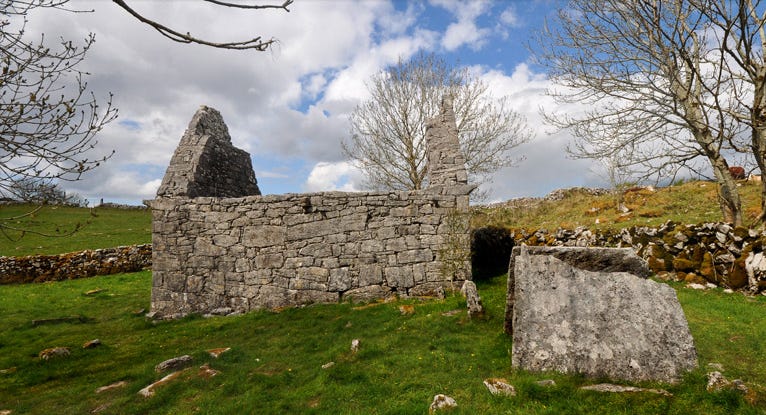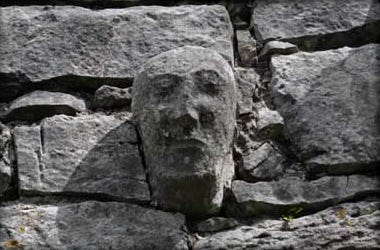St Cronan’s Well, Temple Cronan, County Clare
Temple Cronan is a mysterious, hidden place. Squirrelled away down back lanes in the Burren, under the slopes of a humped limestone hill, it is an ancient site whose history is murky. What remains today is intriguing enough. Squidge through the muddy fields, as my family and I did this last St Patrick’s day, climb over a wall or two and you find yourself faced with a small site hemmed in by drystone walls. Within you’ll find a roofless stone oratory, and two strange pyramidal structures made of heavy stone slabs:
These structures are shrines or graves, known by archaeologists as ‘gable shrines.’ One of them, according to tradition, is the shrine of the site’s founder, St Cronan. Which St Cronan it is (there were at least two) or if he is indeed buried here is not known, as the site has never been excavated. But it is apparently generally accepted that gable shrines were a type of reliquary built to house a saint’s bones. They were designed so that by reaching into them (which you can still do) it would have been possible for a pilgrim to touch the relics.
Temple Cronan appears to be the remains of an early medieval monastic settlement, probably from around the twelfth century, which itself was probably built on the site of a much older church. Though the church is now a ruin, it still contains some beautiful arched doors and windows, and a couple of cyclopean human heads, gazing blankly down from the stonework at pilgrims or curious walkers:
The church building is small but beautiful, especially in the winter sun, which comes down through the space where the roof once was onto the tightly-constructed stonework. Inside the church are little niches, which perhaps once held statues. My son, clearly in a religious mood, decided to recreate the scene as it once may have looked:
You have to walk out beyond the temple itself to find the holy well, which is not signposted. We had to follow our noses and a small footpath and a couple of wandering cows. Around a small cliff and through a clump of leafless trees was a small stone stile, which led us into another enclosure, this time housing the well and the remains of a tall stone cross sitting atop a grassy hillock.
There is a beautiful symmetry to this place, and on this still winter day, despite it being the festival of St Patrick, we found ourselves alone at the well. But then, St Patrick’s Day here is mostly spent in the pub or at a local parade. In fact, this only deepened the sense of ancient peace that seemed to emanate from the small pool of water itself, which is nestled beneath a limestone cliff, and watched over by the ubiquitous statue of Mary:
The larks and the blackbirds were in full song as we climbed over the wall. In the well itself, caddis fly larva bobbed in the gently flowing waters. The scattered coins, and the offerings on the rag tree above, showed that this well is still visited:
There was apparently a popular medieval pilgrimage to Temple Cronan, though whether it included the well is unclear. In the nineteenth century people would come here to make the stations of the cross, though no ‘pattern day’ is recorded. Today, it is clear the people still come, but now they are more likely to come alone, bringing their own needs and prayers and wishes and fears and curiosities. The times we live in have made pilgrimages individual enterprises, like so much else. But a few of us still make them, and when we find places like this, nestled in this old, deep peace, we perhaps remember why.











This sounds like another one of those "thin places", where the barrier between the earthly and the spiritual realms is, at least, semi-permeable. This does not apply to all remote places here in Ireland, there are an abundance of out of the way spots, on bogs, glensides, or hills, which do not evoke the calm and serenity of the "thin places", which are frequently in proximity to well sites or early ruined chapels. The idea of "thin places" fits well with the Irish belief held even in pre-Christian times, that there was another dimension, only occasionally glimpsed, throughout this remarkably beautiful island.
Really good, such a respectful and insightful description of these wells.